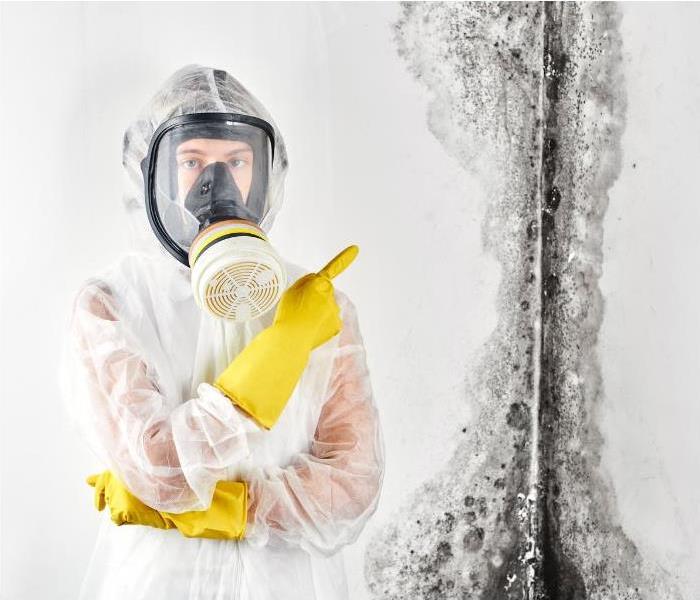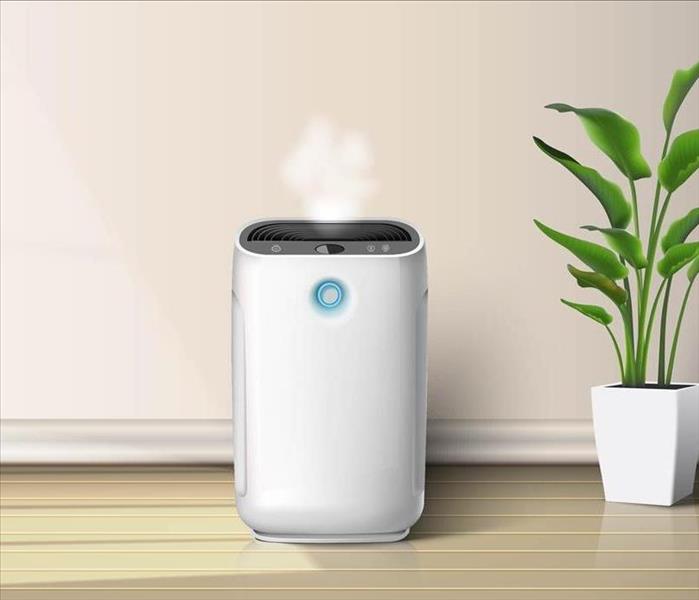Archived Mold Remediation Blog Posts
How to Get Rid of Black Mold in Pueblo, CO: A Comprehensive Guide to a Healtheir Home
3/9/2024 (Permalink)
 Black mold in Pueblo, CO
Black mold in Pueblo, CO
Living in Pueblo, CO, with its unique climate and landscape, brings both beauty and challenges. One such challenge that homeowners may face is the presence of black mold. Mold can be harmful to both your home and your health, making it essential to address the issue promptly and effectively. In this comprehensive guide, we will explore the causes of black mold in Pueblo, CO, and provide practical steps to get rid of it, ensuring a healthier living environment for you and your family.
Understanding Black Mold:
Black mold, scientifically known as Stachybotrys chartarum, is a type of mold that thrives in damp and humid conditions. Pueblo, with its semi-arid climate, can experience periods of high humidity, especially during the summer months. Combine that with any water damage or leaks in your home, and you have the perfect conditions for black mold growth.
Causes of Black Mold in Pueblo, CO:
Water Leaks and Moisture:
Pueblo's dry climate doesn't eliminate the possibility of water-related issues. Leaky roofs, plumbing problems, or flooding can create the ideal environment for mold growth.
Inspect your home for any water leaks, especially in areas prone to moisture, such as basements, bathrooms, and kitchens.
Poor Ventilation:
Inadequate ventilation can trap moisture indoors, promoting mold growth. Ensure that your home is well-ventilated, especially in areas like attics and crawl spaces.
Use exhaust fans in bathrooms and kitchens to reduce humidity levels.
Condensation:
Condensation can occur on windows and cold surfaces, providing a breeding ground for mold. Regularly wipe down and dry these surfaces, especially during the colder months.
Consider using dehumidifiers to maintain optimal indoor humidity levels.
Steps to Get Rid of Black Mold:
1. Identify and Isolate the Mold:
Begin by identifying the areas affected by black mold. Common locations include damp basements, bathrooms, and areas with water damage.
Isolate the contaminated areas to prevent the mold spores from spreading to other parts of your home.
2. Wear Protective Gear:
Before tackling mold removal, protect yourself by wearing appropriate gear, including a mask, gloves, and goggles. This prevents inhalation or skin contact with mold spores.
3. Clean and Remove Mold:
For small affected areas, a mixture of white vinegar and water or hydrogen peroxide can be effective in cleaning mold. Scrub the surfaces thoroughly and allow them to dry.
Larger infestations may require professional assistance. Consider hiring a mold remediation expert in Pueblo to ensure safe and thorough removal.
4. Repair Water Leaks:
Address the root cause of mold by fixing any water leaks promptly. Whether it's a leaking roof, plumbing issue, or compromised foundation, repairing these problems is crucial to preventing mold recurrence.
5. Improve Ventilation:
Enhance ventilation in your home by opening windows, using exhaust fans, and installing ventilation systems in areas prone to moisture.
Consider using air purifiers equipped with HEPA filters to trap mold spores and improve indoor air quality.
6. Use Mold-Resistant Products:
When renovating or remodeling, choose mold-resistant materials for walls, floors, and ceilings. These products are designed to deter mold growth, providing long-term protection.
7. Regular Maintenance:
Establish a routine for inspecting your home for potential mold growth. Regular maintenance, such as cleaning gutters, fixing leaks, and maintaining proper ventilation, can prevent mold issues from recurring.
Addressing black mold in Pueblo, CO, requires a proactive and comprehensive approach. By understanding the causes of mold growth and implementing effective removal and prevention strategies, you can create a healthier living environment for yourself and your family. Remember, when dealing with extensive mold infestations, it's essential to seek professional assistance to ensure thorough remediation and a long-term solution. Taking these steps will not only protect your home but also contribute to the overall well-being of your household in the unique climate of Pueblo, Colorado.
Choosing the Right Air Purifier To Remove Mold Spores
3/24/2022 (Permalink)
 Choose the Right Air Purifier and Avoid Mold Damage by Following Our Tips.
Choose the Right Air Purifier and Avoid Mold Damage by Following Our Tips.
Ensuring your Pueblo, CO home is a safe, welcoming environment means thinking about indoor air quality. Unfortunately, mold spores easily enter the home via open doors and windows or by attaching themselves to clothing and other objects. If those spores get the moisture, warmth and nutrients they need, it may mean needing the services of a professional mold damage company. Installing an air filtration system is one way to minimize spores but not all are created equal.
Types of Purifiers for Mold
Each type of air purifier uses different technologies to clean the air. While some are designed to trap and collect particles, others are designed to simply absorb molecules. When it comes to mold, the former will not help prevent the spread of airborne spores. Below are the top three types made to prevent airborne particles from circulating:
HEPA:
These purifiers feature fine mesh filters that trap approximately 99.7% of pollutants sized .3 micrometers and above. Since fungi spores are typically around 3 to 30 micrometers, this type of device offers optimal peace of mind. A HEPA filter does require frequent replacement. If it is not replaced within six to 12 months, mold may start to collect on it.
Photoelectrochemical Oxidation:
PECO air filtration devices work by light activating a catalytic reaction. Instead of trapping contaminants, it destroys them by changing them into harmless compounds without producing byproducts, such as ozone, or reintroducing them into the air.
Ultraviolet Germicidal Irradiation:
UVGI uses UV lamps to eradicate bacteria, spores and viruses. While it has proven to do what it is designed to, time and area are key considerations. The light has to come into contact with the particles and usually takes several minutes or longer.
How To Choose the Right One
Every home is different, so it’s important to consider your unique situation before purchasing a purifier. Key considerations include:
This calculation is based on the clean air delivery rate. The higher the CADR, the faster and better it is at purifying a larger room. These measurements range in size for the type of pollutant.
This is measured using the Air Quality Index, which ranges from 0 to 500. Anything over 100 means the air quality is poor. It is important to choose a device that lists its AQI rating.
While this may not be a big deal for some people, there is noise associated with moving fans. The higher the setting, the louder it will be. For people who like quiet, a large purifier in a bedroom may not be the best option.
Other considerations come down to personal preferences and budgets. From smart technologies to alert systems, many come with the latest innovations. If budget is a concern, it’s best to research costs associated with filter replacement.
Keeping your home fresh and having peace of mind that pesky spores aren't floating around is important. An air filtration device is a good way to ensure invisible airborne particles are eliminated. To get the most out of your investment, ensure you purchase one that is designed for your needs.
Navigating Commercial Insurance, Mold Exclusions, and Professional Cleanup
11/17/2021 (Permalink)
 Mold grows in almost any environment. Take some steps to prevent the spread of the fungus in your Pueblo, CO, property.
Mold grows in almost any environment. Take some steps to prevent the spread of the fungus in your Pueblo, CO, property.
It doesn't take much moisture to create a welcoming environment for mold spores. If your Pueblo, CO, property is affected by heavy rainfall, melting snow, hurricanes, leaking pipes, or any other type of water disaster, you could end up dealing with mold damage. When mold remains hidden and you don't recognize the problem, the damage can become extensive. If you have a good commercial insurance policy, the mold issue may be covered. It's wise to be aware of mold exclusions, however.
Understand Commercial Insurance for Mold Damage
Mold exists in almost every type of environment, and spores move easily from one host to another. With just a tiny bit of warmth, moisture, oxygen, and food, a spore can establish a colony on wood, carpet, paper, and drywall. As mold feeds, it weakens its food source, eventually destroying property. Mold insurance covers some of the cleanup and remediation expenses.
Limited Fungus Coverage
According to policies from the International Organization for Standardization, Limited Fungus Coverage kicks in when fungus, wet or dry rot, or bacteria is caused by a specific cause and is addressed quickly and appropriately by property owners. Any fungus growth related to flooding may not be covered without flood coverage through an endorsement. If you take action at the first sign of mold, Limited Fungus Coverage usually covers:
- Direct loss or damage
- Removal of fungus
- Tear out and replacement of property
- Removal of damaged property
- Repairs
Your insurance company may limit the amount that is paid out for these services, so it's best to prevent mold growth or catch it early.
Mold Exclusion
Professional mold cleanup services are covered in most situations, but some insurance policies contain mold exclusions. This generally means that there is no coverage for the presence of mold, any spread, or related concerns. The most common reason for exclusion is a failure to properly maintain the property. However, the exclusion cannot apply to:
- Mold or fungus that results from lightning or fire
- Mold growth resulting from specified causes, such as riots, vandalism, sinkhole collapses, windstorms, and damage from firefighting equipment
- Specific losses caused by the presence of fungus or mold
Make sure you understand your coverage before trouble happens.
Maintenance and Prevention
The best mold insurance happens before you need to file a commercial insurance claim. You can take preventative steps to avoid fungus:
- Routinely inspect your building, especially targeting common problem spots, such as vents and drainage systems.
- Use dehumidifiers and fans to reduce the level of humidity in your building.
- Hire professionals to inspect and maintain the ventilation system, including vents, ducts, and working components.
- Take immediate action at the first visible sign of mold or the first whiff of a suspicious odor.
Remember your insurance provider is probably as concerned about preventing the spread of mold as you are. Reach out to your agent or an insurance representative to learn more about the risk of growth and the most effective means of prevention.
Mold can be a real headache for property owners. However, with the proper preventative actions and a good understanding of your commercial insurance, you can reduce the amount of property damage and minimize your own level of frustration.





 24/7 Emergency Service
24/7 Emergency Service


